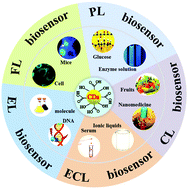There has been an explosion of interest in the use of nanomaterials for biosensing applications, and carbonaceous nanomaterials in particular are at the forefront of this explosion. Carbon dots (CDs), a new type of carbon material, have attracted extensive attention due to their fascinating properties, such as small particle size, tunable optical properties, good conductivity, low cytotoxicity, and good biocompatibility. These properties have enabled them to be highly promising candidates for the fabrication of various high-performance biosensors. In this review, we summarize the top-down and bottom-up synthesis routes of CDs, highlight their modification strategies, and discuss their applications in the fields of photoluminescence biosensors, electrochemiluminescence biosensors, chemiluminescence biosensors, electrochemical biosensors and fluorescence biosensors. In addition, the challenges and future prospects of the application of CDs for biosensors are also proposed.
